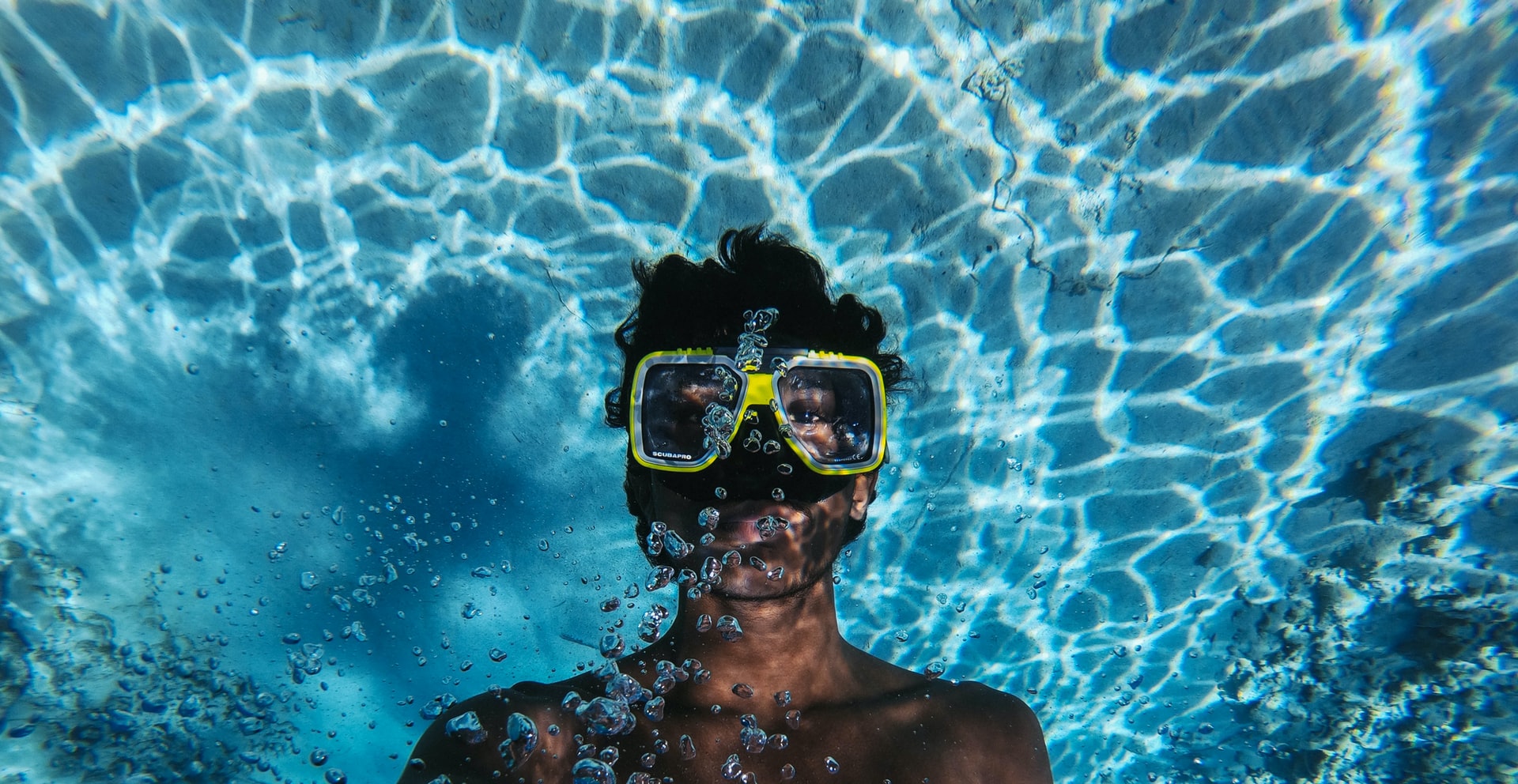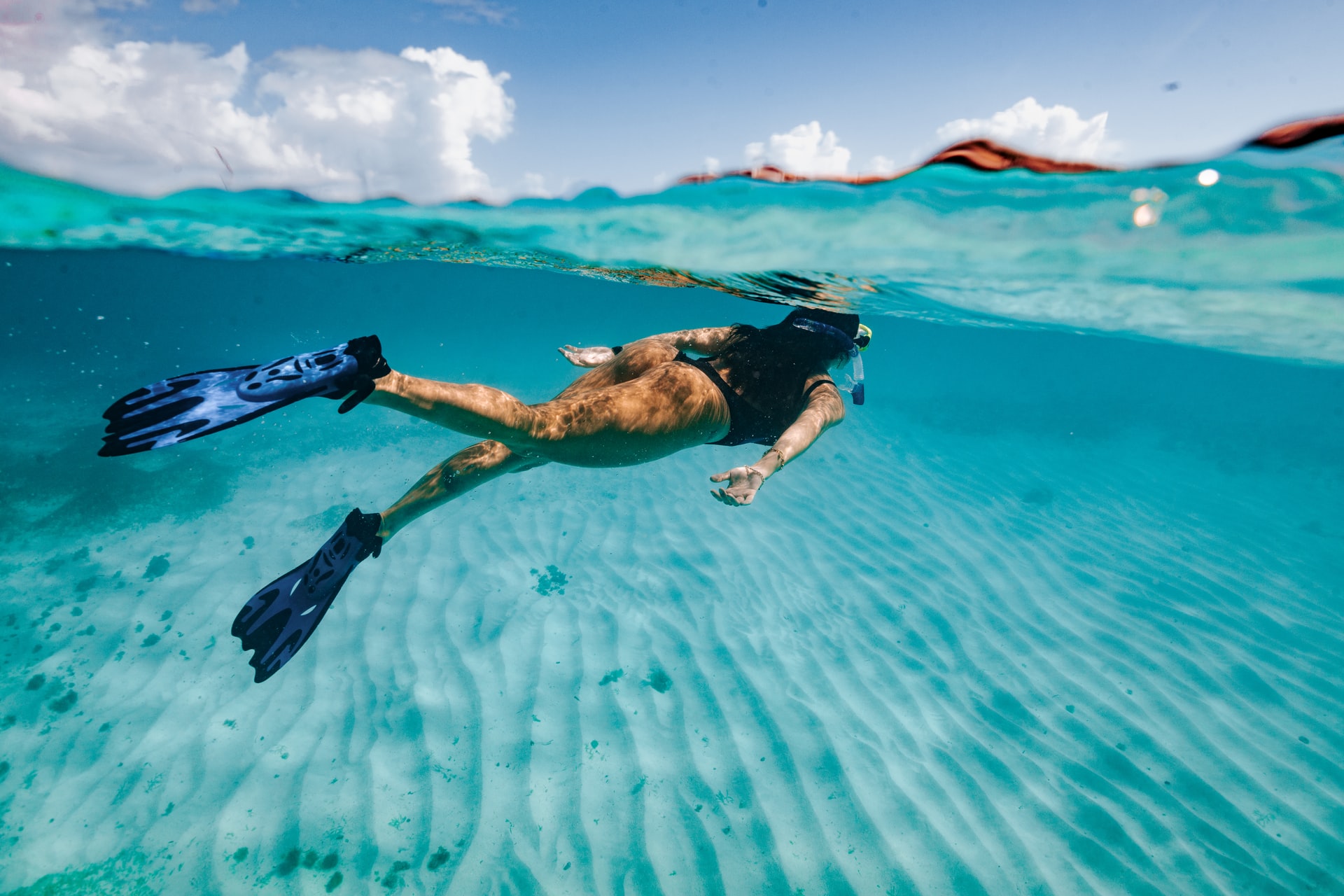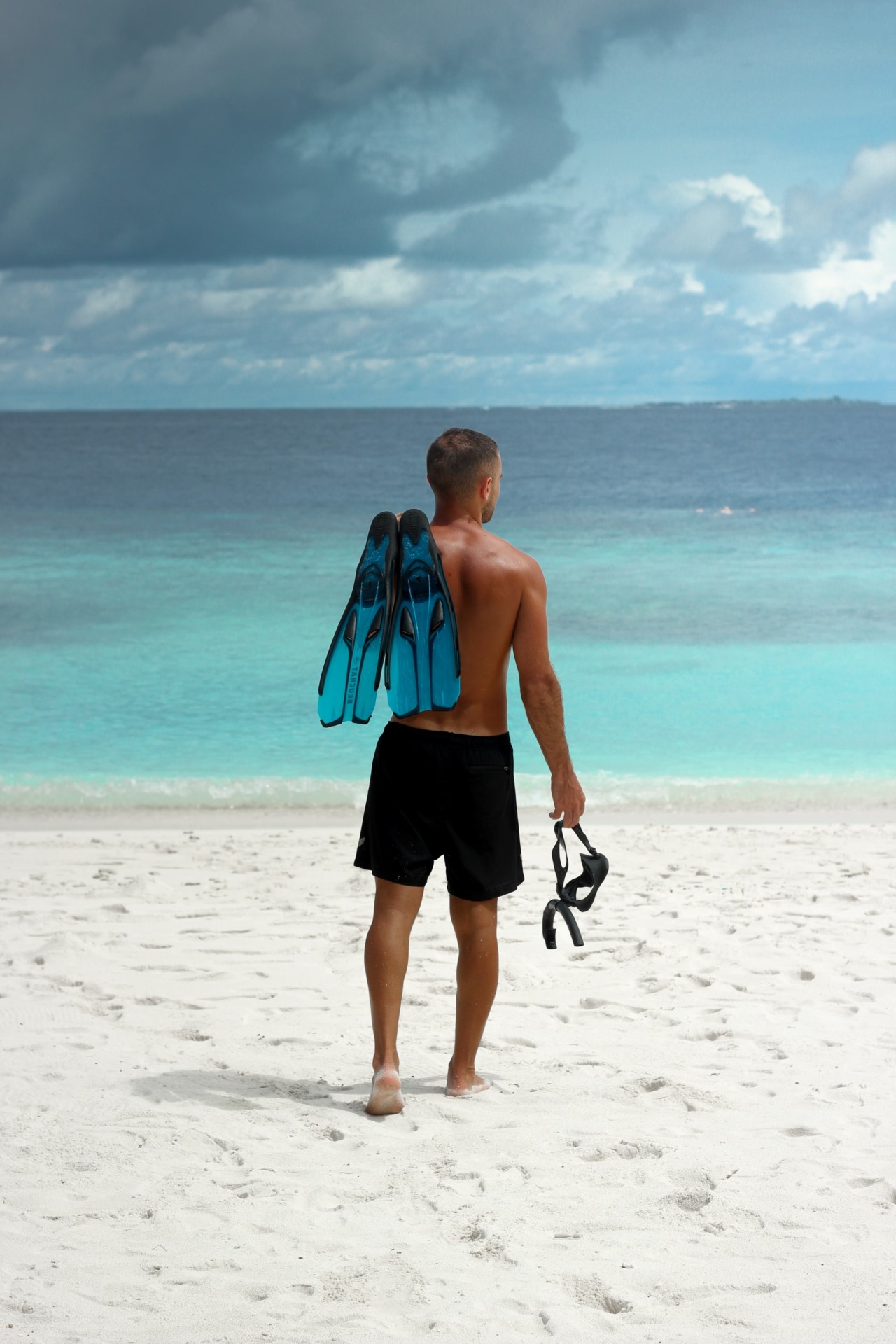Are you new to the world of snorkeling and bewildered by the range of equipment that’s available?
Or maybe you’ve snorkeled already and are not entirely happy with the mask you used?
Whatever the reason you’re interested, we’re going to look at how the different kinds of snorkel masks work so you can get the best possible view of the underwater world.
To make the most of your snorkeling, we will see that the right mask for each person can be different.
We will show you the features to look for to find the best snorkel mask for you.
- Are Snorkel Masks and Scuba Masks the Same?
- What Are the Different Types of Snorkel Masks?
- How Do Regular Snorkel Masks Work?
- How Do Full-Face Snorkel Masks Work?
- Are Full-Face Snorkel Masks Dangerous?
- Are Full-Face Snorkel Masks Easier To Use?
- Can I Breathe Through My Nose When Wearing a Snorkel Mask?
- Which Type of Snorkel Mask Is Right for Me?
- Conclusion
- You Might Also Like…
Disclosure: this post contains affiliate links (clearly marked with ), which means we may earn a commission if you buy something through them, at no additional cost to you.
Are Snorkel Masks and Scuba Masks the Same?
Traditional snorkel masks and scuba diving masks are basically the same to look at.
They both share the same standard general design where your eyes and nose are enclosed inside the mask space.
There is an adjustable strap to tighten the fit of the mask to your face and a soft plastic or rubber flexible skirt and seal to stop the mask from letting in water.
The main physical design difference you will see between standard snorkel masks and a scuba mask is that a scuba mask will often have a lower profile with a smaller air space inside the mask itself.
This is because when you are scuba diving, if some water does get into the mask, you want to be able to use as little air as possible to blow it out.
This isn’t such a problem in a snorkel mask as you are at the surface where there is all the air you could ever need.
Snorkel and scuba-specific masks often differ in the quality of the materials used in their manufacture.
Masks sold for snorkeling in vacation resorts have usually been built to be as economical as possible.
This means that the materials used, particularly for the lens or the mask seal, may not be as resilient or strong as those used in masks for scuba diving.
Cost savings might make a cheap snorkel mask more prone to leaking or to damage from sunlight.
Good quality scuba diving masks have high-quality silicone seals and safety glass lenses that make them more expensive.
Because recreational scuba divers with the proper training can go as deep as 130 feet / 40 meters (and technical divers even further), scuba diving masks are subjected to significant pressures, and failure would be catastrophic.
These pressures mean that scuba diving masks are built and tested to higher standards than basic snorkel masks.
So while snorkeling and scuba diving masks generally look the same, most people will consider that they can use a scuba mask for snorkeling, but a snorkeling mask might not necessarily be great for scuba diving.
You cannot use the full-face type of snorkel mask for scuba diving under any circumstances.
In addition to not being able to breathe through your regulator, you cannot readily equalize your ears or the mask air space with a full-face mask, and the various valves that control the airflow at the surface would fail underwater pressure causing a complete mask flood.
Special scuba diving full-face masks do exist and require special training to use.
What Are the Different Types of Snorkel Masks?
We can break down snorkel masks into two main categories.
- Regular masks that enclose your eyes and nose.
- Full-face snorkel masks that cover your whole face.
Regular masks come in several types:
Traditional Masks have two lenses (a left and a right), and there will be a solid frame between the two. This type of mask is the most commonly used mask for snorkeling.
Frameless Masks or single-lens masks don’t have the center frame and so can feel more open to look through. This can be an advantage if you’re looking at something that’s quite close.
These tend to be more commonly found in scuba diving-orientated masks and they are more expensive.
Nose Purge Masks have a valve built into the bottom of the nose pocket that some people find makes it easier to clear water out of the mask.
Smaller-Size Masks are designed for smaller faced adults and children, since snorkel and scuba masks need to fit the user’s face correctly.
Prescription Masks: as it’s not possible to wear glasses with a regular snorkel mask, you can purchase this kind of mask with corrective lenses built in to give a crystal clear view.
Specialty Masks: the industry has come up with many specialty masks that have features like tinted lenses, or action camera mounts.
How Do Regular Snorkel Masks Work?
A regular snorkel mask puts your eyes and nose into a dry mask space.
The airspace in front of your eyes allows the usual amount of refraction to occur, giving you the same clear vision as you have on the surface.
Without the airspace to look through, not only would it be very unpleasant with water in your eyes, but the different refraction from the water would make everything blurry.
The mask will have a thick adjustable strap to tighten the fit of the mask to your face.
Your snorkel attaches to the strap with its clip.
There is a flexible nose pocket that you can use to equalize your ears if you want to try duck diving.
To stop the mask from letting in water, there is a soft plastic or rubber seal that fits the shape of your face.
The mask’s skirt and seal can be transparent or opaque, and many people have a personal preference as to which they prefer.
Some people find transparent masks to make them feel comfortable, while in others, they can cause vertigo.
Similarly, some people like a black mask skirt, but others find them claustrophobic.
Your mask must fit your face properly, or it will leak constantly.
To test if a regular mask fits you correctly, you should hold it on without the strap while you face down and see if you can keep it in place by just breathing in through your nose.
A well-fitting mask should stay on as you inhale gently, and you should feel like it is sucking onto your face without air leaking in.
Everyone’s face is different, so you might have to try different masks out.
This is one of the most common reasons why vacationing snorkelers have problems with rental masks.
The masks are often all the same size or worn and don’t seal properly, leading to constant leaking.
Having your own mask, no matter how often you snorkel, will mean that you’re less likely to have leaks and will enjoy your snorkeling more.
People with smaller faces or children can try smaller-size masks to find one that fits well.
Men find that they often need to shave before snorkeling as beards can make regular masks leak.
How Do Full-Face Snorkel Masks Work?
Full-face masks combine the functions of the ordinarily separate mask and snorkel into one complete unit.
They have a large viewing window that provides clear vision and an outer silicone seal to stop water from getting in that runs from your chin to your forehead.
Some straps go around the back of your head to hold the mask on securely.
Full-face masks have an inner pocket that seals around your nose and mouth, and this is the area you breathe from.
The short snorkel part of the mask has two sections, one for fresh air to come into the inner pocket and one for your exhaled air to leave.
This U-shape, one-way design means that you always breathe in fresh air from the relatively small inner pocket.
To stop water from entering while you breathe, a valve is fitted to the snorkel pipe, similar to what you find on a dry snorkel.
Full-face masks also have a valve at their base designed to let water out of the outer air space.
Are Full-Face Snorkel Masks Dangerous?
The most crucial factor with a full-face mask is that they fit correctly.
Quality manufacturers produce these masks in many different sizes so that you can ensure that the outer seal fits and, most importantly, that the inner pocket seals completely around your nose and mouth.
The most significant risk with using a full-face mask is from breathing in what is called dead air.
When we breathe out, we exhale air that contains carbon dioxide.
This is only a problem if we breathe in that same air again.
If the full-face mask inner pocket doesn’t seal properly, then we can bypass the snorkel’s one-way system and end up breathing in the same air with each breath from inside the mask.
This can lead to headaches, fatigue, or even worse, unconsciousness, which can cause drowning.
Additionally, you must pay attention to ensure that the various seals and valves on the mask are in good condition and working correctly.
If one of the one-way snorkel valves should stick open, then you can also end up breathing in dead air or have the mask fill with water.
If you do want to purchase a full-face snorkel mask, you should make sure that you only buy one from a reputable manufacturer and ensure that it fits your face correctly.
Carefully follow the supplied instructions for operation and maintenance every time that you use it.
Are Full-Face Snorkel Masks Easier To Use?
Many people find traditional masks and snorkels challenging to use, especially when they start.
Although a separate mask and snorkel set will usually be cheaper, easier to maintain, and more flexible with what you can do with it, several issues are pretty common.
A full-face mask addresses many problems through its design, but whether someone will find it easier to use will depend upon the individual.
For example, a regular snorkel can be put on easily, and there’s very little maintenance to do after using it other than a quick rinse with fresh water.
Full-face snorkel masks need to be carefully adjusted and checked before each use to ensure they are safe and afterward need to be more thoughtfully cleaned.
In the water, while many people don’t get on with them initially, techniques to clear water out of the regular mask and snorkel are pretty straightforward, and if you do have a significant problem, then they’re simple to take off.
A full-face snorkel mask is more difficult to take off and put back on in the water and is generally a lot more cumbersome to use and travel with.
However, many people find them comfortable and easy to use in practice, and their growing popularity with beginners or infrequent snorkelers would undoubtedly suggest that they are useful.
Whether they are easier for you will depend on what you want to use them for and how difficult you find a regular mask and snorkel.
We will look at some of the factors to help you decide below.
Can I Breathe Through My Nose When Wearing a Snorkel Mask?
With a regular mask, you cannot breathe through your nose as it is inside the mask air space.
However, as your nose is inside the inner breathing pocket, you can breathe in through your nose with a full-face mask.
Your nose is inside a regular mask so that you can equalize your ears and the mask space as you descend when duck diving and the water pressure increases.
The most common method to equalize your ears is to pinch your nose through the flexible pocket and gently blow against it.
This method isn’t available with a full-face mask as your nose is behind the solid mask window.
So while you can breathe through your nose with a full-face mask, it might come at the cost of not being able to duck dive.
Which Type of Snorkel Mask Is Right for Me?
Choosing which snorkel mask is for you will depend on several factors.
Some of the reasons that people might find snorkeling scary or uncomfortable are connected with the equipment.
Having a well-fitting mask and using a dry snorkel can address many of the common problems with water getting in that people find off-putting.
However, other problems are harder to solve when using standard equipment.
For example, many people find the snorkel mouthpiece uncomfortable or challenging to bite onto or suffer from a bad gag reflex.
The full-face mask doesn’t have a mouthpiece, so you can breathe more comfortably.
Similarly, some people find not breathing through their nose uncomfortable and enjoying a full-face mask more.
On the other hand, some people find full-face masks uncomfortably cumbersome to wear and claustrophobic.
So, your choice will mainly come down to what you personally prefer.
However, there are also some general guidelines as to which type of snorkel mask might be better for your needs.
A Regular Snorkel Mask Is a Great Choice For
- Duck diving and freediving as you can equalize your ears easily, and there aren’t any valves to go wrong and leak water at depth
- Travel as it’s smaller to carry
- Easy use – Needs less maintenance
- Vigorous exercise as a regular snorkel is better suited for heavier breathing due to its larger diameter
- Snorkeling in rougher conditions where the valve on a full-face mask might make smooth breathing difficult as it is pretty low in the water
- More economical – Generally, a separate mask and snorkel are cheaper than a full-face mask
- A good quality regular mask can also be used for scuba diving
A Full-Face Snorkel Mask Is Ideal For
- Relaxed snorkeling in calm waters
- Anyone that suffers from a bad gag reflex
- Anyone that prefers to breathe through their nose
- People that find a regular mask makes them claustrophobic or uncomfortable
Conclusion
Both regular and full-face snorkel masks allow people to enjoy the beauty and excitement of the underwater world.
Which mask is the right choice depends mainly on the individual and their personal preferences.
Regular masks are straightforward to use and maintain for many people, are cost-effective, and flexible with what you can do with them.
But for others, the invention of the full-face mask has meant that they can now enjoy snorkeling where they didn’t get on with it before.
While they can be more expensive, more time-consuming to maintain, and must fit an individual correctly to be safe, full-face masks can give a user a comfortable and clear experience.
You Might Also Like…
-

Can You Drown Snorkeling? 11 Common Reasons (+Helpful Tips)
-

Can I Use Snorkeling Fins for Bodyboarding? Pros & Cons (+6 Tips)
-

What Colors to Avoid When Snorkeling? (& Which You Should Wear)
-

Is It Safe to Fly After Snorkeling? What You Should Know (+4 Tips)
-

Can’t Hear After Snorkeling? 3 Possible Causes (& Solutions)
-

Can Snorkeling Cause a Sinus Infection? (+9 Tips to Avoid It)
-

Can Snorkeling Cause a Sore Throat? 8 Common Causes (+Tips)
-

Can Snorkeling Cause Vertigo? (+8 Tips to Avoid It)
-

How Do Snorkel Masks Work? (+Regular Vs. Full-Face Masks)
-

Why Does Snorkeling Make Me Nauseous? (11 Causes & Remedies)
-

What Does Snorkeling Feel Like? FAQs Answered (for Beginners)
-

Does Rain Affect Snorkeling Visibility? 4 Ways It Does (+Helpful Tips)







